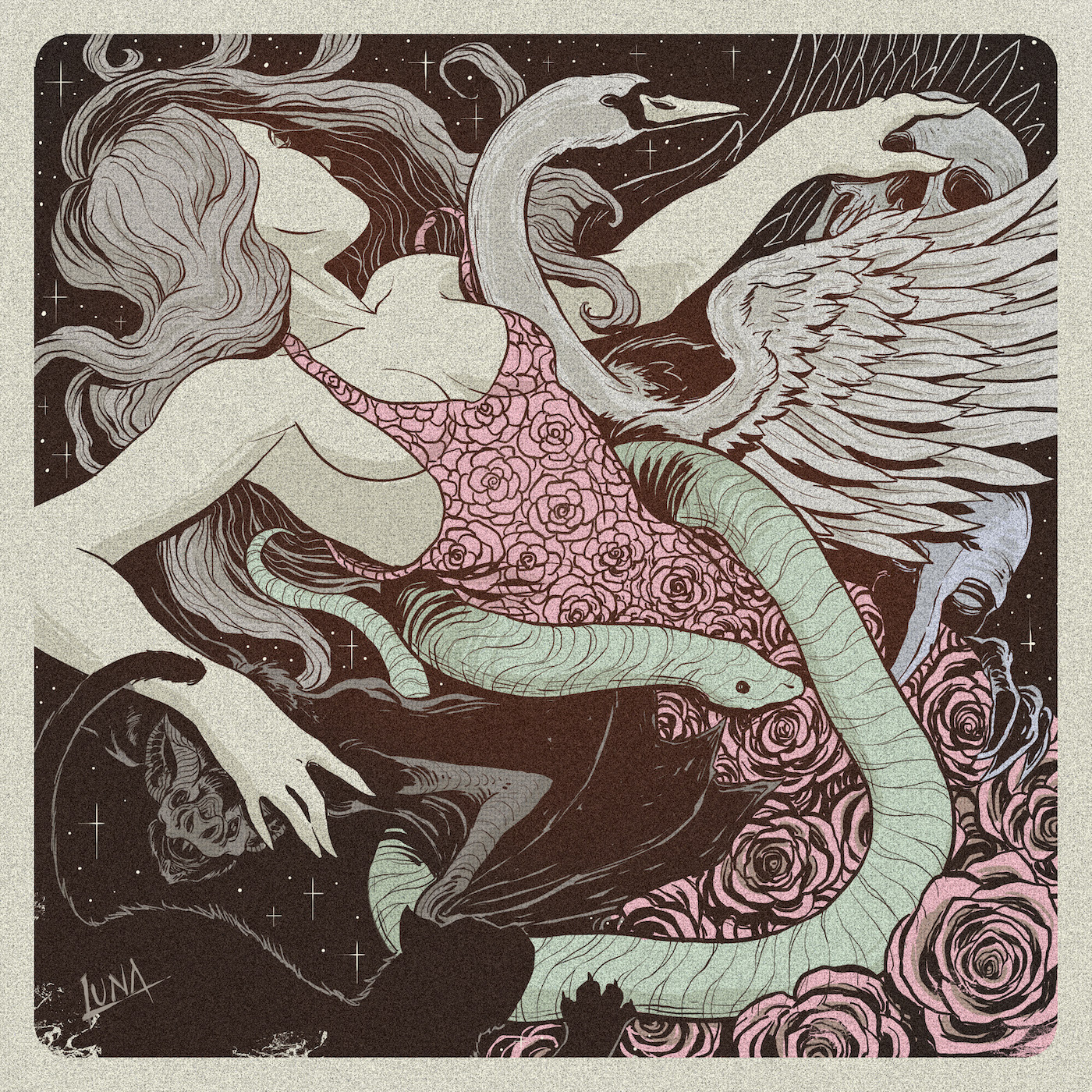Guest Album Review – “Never For Ever” by Kate Bush
This guest review was originally part of a music blog project I created called Under The Deer. Since that site won’t be around forever, I’m archiving these wonderful reviews and their accompanying illustrations here. Writer and illustrator listed at end of the review.
When remembering the music of Kate Bush, critics usually point to 1985’s Hounds of Love, or its 1988 follow up, The Sensual World as the singer’s high points. Both are undoubtedly excellent albums, but for my money 1980’s Never For Ever is still Bush’s most compelling listen. Why? Because it represents the moment a great artist realized her full potential.
To understand the revelatory impact of Never For Ever, some context is necessary. Circa 1980, Kate Bush was a musician frustrated. She’d exploded onto the scene with her debut album, The Kick Inside in February 1978; a dramatic and bombastic blend of pop, art-rock, and prog that established the singer as a star almost overnight. That album was a labor of love, taking two years to record. But, EMI – mistakenly seeing Bush as a flash-in-the-pan phenomenon – was insistent that she bring in her second disc in a matter of months.
Coming out at the tail end of 1978, Lionheart was, by Bush’s standards, a rush job. Only three of the record’s ten tracks were newly composed for the album. The rest were leftovers from her teenage years, songs written before her debut. An uneven record, it was summarily dragged across the coals by the critics. Chris Westwood of Record Mirror was perhaps the most scathing, describing a “bland and soulless” record “which is at best moderate, lacking and often severely irritating…” Even Bush herself was openly critical of the album in interviews: “Considering how quickly we made it it’s a bloody good album, but I’m not really happy with it”.
Lionheart was a product of record label interference that undermined the reputation Bush had built for herself. Realizing that another dud could torpedo her career, the singer became the master of her own destiny on its follow-up. For the first time, she produced the record herself, affording ultimate control over the project. Peter Gabriel, whose third album Bush had appeared on, was a clear influence, both in his individualistic approach, and his choice of instrumentation. The Fairlight CMI synthesizer – a favorite tool of Gabriel’s – was utilized extensively on Never For Ever, employed to create the luscious, immersive textures that characterize the album.
When it came out in 1980, Never For Ever, was the most expansive and conceptual work that Bush had released. It is suitably Floydian in parts, unsurprising given the early mentorship that Bush received from Pink Floyd guitarist Dave Gilmour. That influence seldom dilutes the impact of Kate’s distinctive voice. This is an album where Kate Bush, as songwriter, really shines through; It often feels like an aural storybook, creating a rich tapestry of tales drawn from the annals of history, art, and popular culture. From her imagining the final years of composer Frederick Delius’ life in Delius to retelling the 1961 Brit horror film The Innocents in Infant’s Kiss, Bush’s lyrics bring a new and deeply personal perspective to old tales.

It’s an album of many strong moments. Babooshka, the record’s most well-known song, has lost none of its initial impact. Its compelling, understated, piano-driven verses contrast magnificently with the explosive, bombastic choruses, which affirm Bush’s status as one of the great voices of her generation. The Wedding List and the riotous, pseudo hard-rock of Violin are slyly witty and immaculately constructed. But it is the closing one-two punch of Army Dreamers and Breathing that is Never For Ever’s undoubted highlight. The former, a song about a mother wrestling with the guilt she feels over a soldier son’s death is sparsely arranged, with Bush’s understated vocal delivery proving particularly powerful.
Contrasting Army Dreamers’ sparsity, Breathing is a full-blown, five-minute rock opera; a tale of nuclear Armageddon uniquely told from the perspective of a fetus in utero. The song is the album’s most evocative moment, capturing the abject terror of an unborn child who, in the face of apocalyptic catastrophe can do nothing but “breathe the fall-out in. Out, in, out, in.” As the track reaches its very literal explosive crescendo (a terrifying, fictional news report announces the dropping of an atomic bomb), Bush offers her most impressive vocal moment of the record, an impassioned cry of “God give me something to breathe” that pierces over collaborator Roy Harper’s monotone and almost emotionless repetition of the phrase “what are we going to do? We are all going to die.”
The impact is lasting, resonating long after the song has finished.
37 years after its release, Never For Ever still shines as a catalytic moment for Kate Bush. It’s a fact reflected in the record’s phenomenal sales achievements; it was the first solo album by any female solo artist to enter the UK charts at number 1 and it stayed in the UK top 75 for a total of 23 weeks. But it’s not just the sales that make Never For Ever special. Powerful and compelling, displaying incredible maturity from the-then 23-year-old, it set Bush up for a string of classics – The Dreaming, Hounds of Love, The Sensual World – that are amongst the greatest albums of the 1980s. It’s because of the acclaim of those successive records that Never For Ever is often overlooked. It shouldn’t be though; it’s a forgotten classic, fully deserving of re-evaluation.
Contributors

Alec Plowman (Norwich UK) is a popular music obsessive. A journalist by day, he recently completed a Ph.D. on the history of live recordings (technically he’s a doctor of rock). When not writing about music, he plays it, fronting hard rockers Monster City.

Franco Luna is an illustrator, graphic designer and comic book enthusiast based in Mendoza, Argentina.